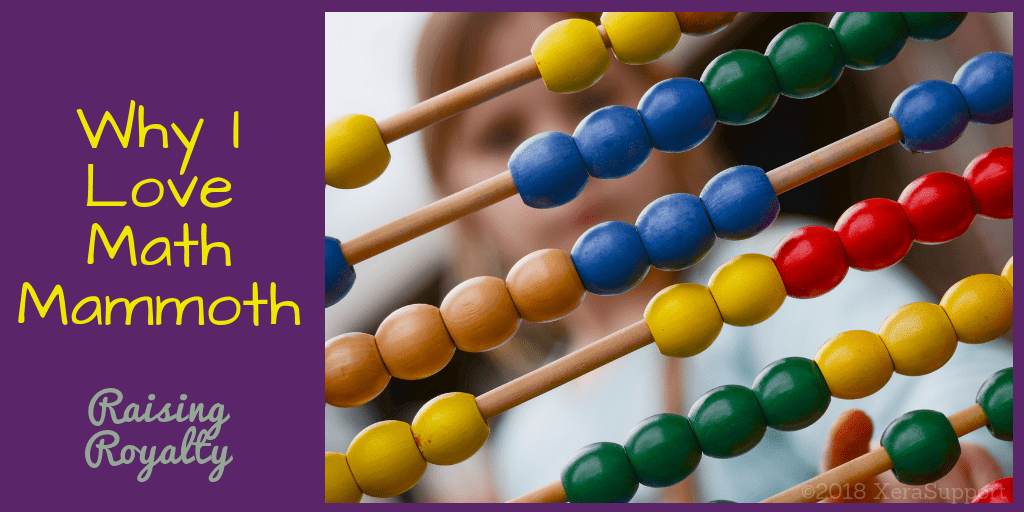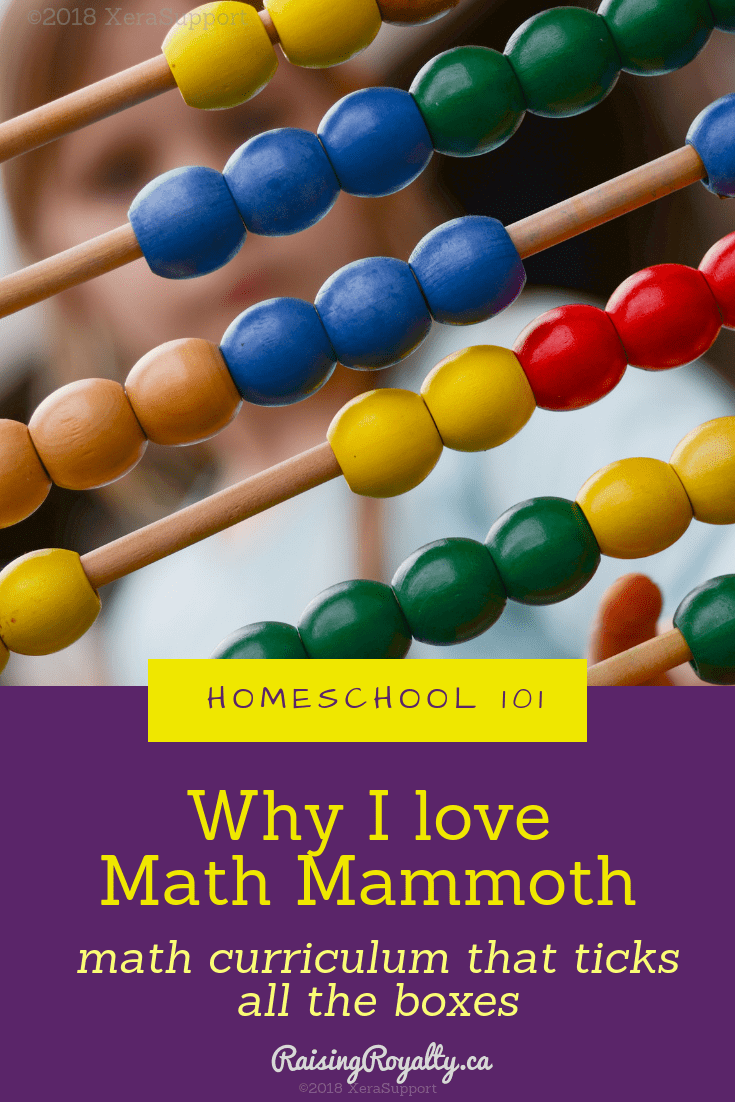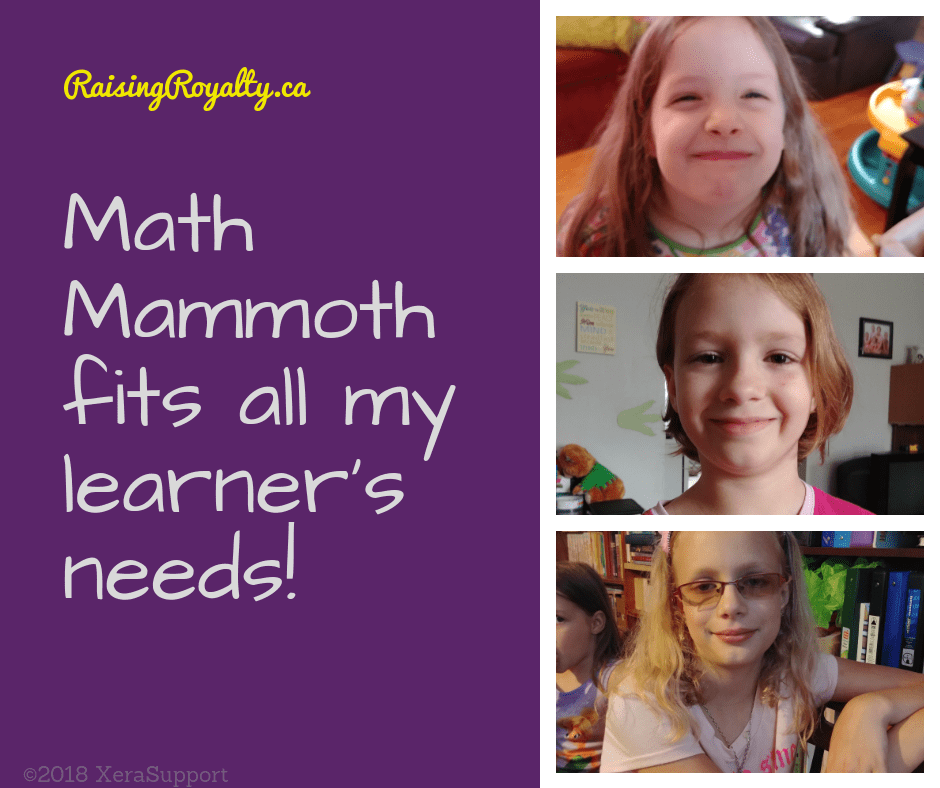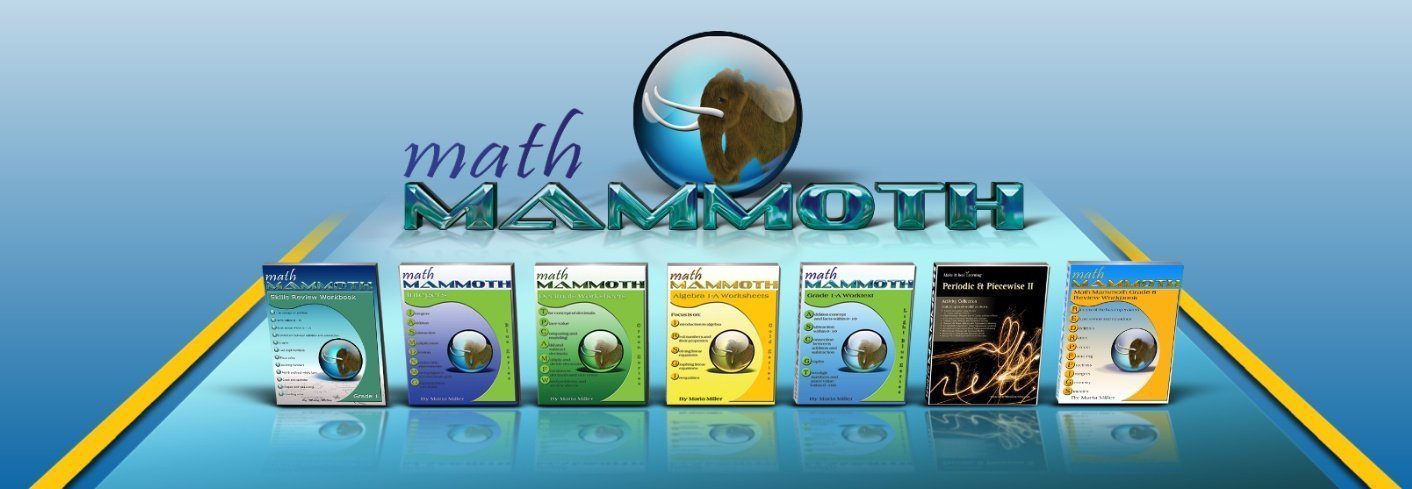
Homeschool math is tricky. We struggled with finding the right program for years. I discovered Math Mammoth about 5 years ago, and boy do I wish I had known about it sooner. Math Mammoth is a math program that ticks all the boxes for me, and I LOVE it. It’s one of the few curriculum programs I will recommend whole-heartedly.
And just so you know, this review is not requested or sponsored by Math Mammoth in any way, though I’m sure they will appreciate it.
On to why I love Math Mammoth.
1. It’s self teaching.
Math Mammoth is structured in short lesson format. Each lesson contains a few paragraphs to introduce or review the concept, along with a few examples. An independent reader can take a lesson, go through the reading section and the step-by-step examples, and then go through the rest of the lesson themselves. And they would come out with a thorough grasp of the concept, with no outside help.
The exercises build upon themselves. Each section isolates part of the skill being taught or reviewed, so that the student can practice without getting confused. In the later review sections, students are asked to combine previous skills to more complex problems, thus expanding the applications, and encouraging problem solving skills.
I especially like the “Puzzle Corners”, where students are challenged to try to figure out the next concept before it’s introduced, with little math puzzles. I always make these optional, but they’re fun to try.
2. It’s Open-and-Go
There’s no prep, script or extra instructions for this curriculum. You can print off a section, and either go through it or hand it to your student, with no extra instruction or planning needed. And because it’s self-teaching, parents don’t need to remember how to do all these math skills themselves.
Math Mammoth teaches skills from a variety of methods. It will teach the “old-school” methods those of us who went to school before “common core” or “discovery math”, but it also teaches some of the mental math tricks that “common core” attempts to teach. Math Mammoth is just more obvious and straight-forward about it. And that means that it’s easy to follow, even for parents who struggle with common core techniques. You won’t be confused with Math Mammoth!
3. It’s CHEAP.
Seriously, people, Math Mammoth is cheap compared to some math programs out there. Where some math programs can charge $80-$100 per grade, I was able to get bundle packages of Math Mammoth for $100 for 3 years at a time. And there are even better discounts available at certain times of the year, through the Homeschool Buyer’s Co-Op.
Oh and it’s a digital, printable curriculum. That means that there’s no shipping to pay for. Printing can be done at home, or for a few dollars at a print shop. And because it’s digital, if you’ve got more than a few students, you can reuse the curriculum from year to year. So that $300 I spent to purchase the entire graded curriculum will work out to about $8 per child per year for math curriculum!
And there’s no separate teacher’s manual or answer book to purchase. It’s all included. That just saves more money.
There are CD and printed versions available, if you so choose.
4. It’s comprehensive.
Math Mammoth comes in 3 different sets. You can get the “Light Blue” series, which is the full-year, graded curriculum. These come with student worktexts, answer books, tests, and extra practice worksheets. Math Mammoth has 7 different levels, from Grade 1-7.
You can get the “Blue” series, which are the topical workbook supplements. These are the same curriculum lessons as in their graded books, but arranged differently. For example, you can get the Addition and Subtraction set, which contains all the addition and subtraction lessons from their graded books, starting from Gr 1 all the way up to Gr 7, in one self-contained set.
Then there are the “Golden” and “Green” series. These books are supplemental books, made for tutors and extra practice. The Golden series is for Grades 3-8, organized by grade, and the Green series are for Grades 3-7, organized by topic.
Math Mammoth also has summer review books, which don’t have any instructional portions, and cover all the review sections from the Blue series. They are mixed, not topical, but they aren’t needed if you have the Light Blue series (as they would be repeats of worksheets already done).
Math Mammoth has a couple of other products too. The Make It Real series is meant as extra practice, and application to real-life situations, such as cell phone plans and music downloads.
The WTM Math Foundations curriculum is part of a collaboration between Math Mammoth and the Well Trained Mind. It contains a selection of exercises from Math Mammoth’s Light Blue series, arranged in a one-year format. It’s designed for students who have completed another math program, but are still shaky with basic math concepts.

5. It’s academically advanced.
I didn’t realize this when I first bought it, but Math Mammoth is advanced! For example, there are algebraic concepts taught as early as first grade. But because Math Mammoth is so gradual and builds so systematically, the concepts are easy to grasp and to follow.
My oldest daughter hated math before Math Mammoth. I didn’t get it until she was in 6th grade, and when I did the placement tests, she tested into 4th grade in Math Mammoth. We were both a little shocked, and I figured it was because we had done such a poor job before.
Within a few months of switching to Math Mammoth, my daughter was, if not enthusiastic, no longer fought me when it came to math. She completed the work, rather than dragging it out for hours. And, she didn’t require me to teach her anymore, removing another source of frustration for both of us.
We completed the 5th grade level of Math Mammoth before she started high school. I was nervous, thinking she was behind in math, so when choosing her courses, we went for the applied math course, rather than the academic. And, to our surprise, not only did she NOT struggle with math — it turned out that our freshman high school math course was a REPEAT of level 4 Math Mammoth.
Because of Math Mammoth, my daughter won an award in her high school for having the highest math mark in her grade for that class.
Moving on to 10th grade was even more of a surprise. Due to her success in her freshman math class, the head of the math department gave her permission to move up to the academic (honors) math class. And she excelled again. The work she had done in Math Mammoth 5A & B was repeated again in the first half of her Grade 10 math class.
Since then, we’ve compared Math Mammoth with our local public high school curriculum. My best estimates is that by the time my girls finish Math Mammoth 7, they will have completed the equivalent of a Grade 11 math education in our area, and be ready for senior high school math courses: Algebra, Calculus, & Trigonometry.

6. It’s mastery based.
If you haven’t realized yet, there are two kinds of math programs: spiral and mastery. Spiral is typical of most public school math programs, which work like a spiral staircase. They have a cycle of introducing new concepts and reviewing old ones, never spending a lot of time on any one concept and jumping around from topic to topic over the course of the year. Mastery stays on one topic and covers it thoroughly, before moving on to the next. There’s lots of drill and extra practice in a mastery-based program, and students will “master” one concept before moving on to the next. And the only times they’ll come back to those topics is in bits of review after each concept is mastered.
Spiral works great for kids who get bored quickly, and hate drill. Mastery is great for students who need extra practice before moving on to the next thing. There are pros and cons for both styles, but switching between them is tricky.
Math Mammoth is mastery based, but with enough review that you never really lose touch with older topics. And there’s enough spiral in the program, that concepts are brought up again from year to year, building upon skills mastered in previous years. I love the way we get the best of both styles inside Math Mammoth.
7. It’s easily used with other programs.
Math Mammoth, because of it’s self-teaching and mastery-based nature, is easily used to supplement other math programs. In fact, it’s got options to do just that! That means that you can keep the same curriculum you’re using right now, and still be able to use Math Mammoth to help cement skills and concepts with your students.
8. Support is available!
Math Mammoth is designed that all the pieces work together. So if your child needs extra practice, you can use the Blue, Golden or Green (or even the Review) series to supplement. And you can get lesson plans, teaching videos and direct support from their website.
The author of the curriculum has also created a free email course on teaching math. They’ll teach you how to teach a struggling student, when to use timed tests, and the value of mistakes, along with common math issues, such as teaching multiplication or fractions.
And when you sign up for their email list, you’ll get discounts, free worksheets, and tips and tricks for teaching math. Check out all the free support!
9. It’s black-and-white.
So this has got to be one of my favorite parts of the program. It’s black and white. While there are occasional visual elements to help explain concepts or aid in calculation, there are no cartoons, clip art, or bright colors to distract or confuse a child. And since there are no visual elements, I get to add in my own visual aids for teaching a concept.
So when my 2nd daughter struggled to understand addition concepts, we pulled out apples. And when my 4th daughter had trouble with place value, I could use an abacus or lego to help, without confusing her.
Math Mammoth does offer a color-version printable, as well as printable manipulatives, for those who need that. But for me, I loved that it printed (well!) in black-and-white.
10. International versions are available.
Many homeschool programs are American-based. So for those of us in other countries, we’re often left with American money, American measurements, and American-based word problems. And then we have to supplement to cover our own currency and measurements.
Math Mammoth has versions available for the international market. It has a separate curriculum for South Africa, the US, and an international version. The international version isn’t specific to any one country, but contains a money chapter specific to US, British, European, South African, Canadian, and New Zealand currencies. It offers the Metric system instead of the Imperial system (meters instead of feet), and formats their spelling and numbers according to British usage, instead of American.
We love Math Mammoth.
I can’t say enough about why I love this program. It suits all my learning styles and challenges. My gifted child can work at her own pace, and my special needs child gets all the support she needs, using the same program. I can supplement as I need, and I don’t have to get something different for money or measurements, just because I live in Canada. And, it’s super affordable!
To buy:

What’s your favorite math curriculum?
For more homeschool tips: How do I Homeschool My child?

I’ve never used this math program before. I may have to check it out – sometimes I use a couple resources for math – I find it helps to reinforce concepts.
Thanks for sharing!
We love it. It’s working for multiple ages and abilities too. I highly recommend it.
We switched over to Math Mammoth mid year and I couldn’t be more pleased 😊
Thank you so much for your thorough review. I just bought the pdf versions of the blue, light blue, golden/green plus review series to supplement my kids’ learning at school, especially given the rocky spring and possibly rocky fall ahead! I am in Canada as well, so I appreciate hearing reviews from Canadian homeschoolers like you! I am hoping to be able to supplement or homeschool (who knows?) for years to come with a single purchase! A good deal!
I’m so glad you liked my review! Math Mammoth has been an incredible resource for my family, and one we’ll be using for years yet. One of the best purchases I’ve ever made!
Thank you for this post. We started Math Mammoth this year for my 3 kids (1st, 3rd, and 5th) and LOVE it. It’s so simple to put together each day and yet so thorough. The way things are laid out are perfect — everything just clicks for all three of my kids.
But seriously thank you for the encouragement about how advanced it is. My (5th grade) son tested into gr3 of math mammoth and my (3rd grade) daughter into gr2 of math mammoth. I was worried about trying to catch them up, but what you said about how well yours did in high school with a similar scenario was super encouraging. So I’m not even going to worry about it. But I DO wish I had found and started it with all my children from the beginning. It’s already such a huge hit in our house and I’m so happy to have math down pat as of now. Yay!